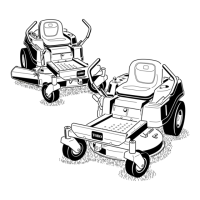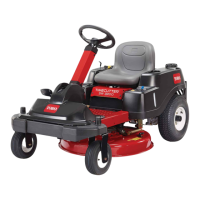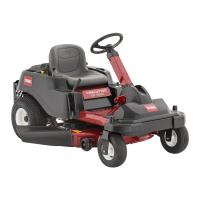Maintenance
59
Adding Water to the Battery
The best time to add distilled water to the battery is
just before you operate the machine. This lets the
water mix thoroughly with the electrolyte solution.
1. Clean the top of the battery with a paper towel.
2. Lift off the filler caps (Fig. 53).
3. Slowly pour distilled water into each battery cell
until the level is up to the lower part of the tube
(Fig. 53).
IMPORTANT: Do not overfill the battery
because electr
olyte (sulfuric acid) can cause
sever
e corr
osion and damage to the chassis.
4. Press the filler caps onto the battery.
Charging the Battery
IMPORTANT: Always keep the battery fully
charged (1.260 specific gravity). This is
especially important to prevent battery
damage when the temperature is below 32°F
(0°C).
1. Check the electrolyte level; refer to Checking
Electrolyte Level, page 58.
2. Remove the filler caps from the battery and
connect a 3 to 4 amp battery charger to the
battery posts. Charge the battery at a rate of 4
amperes or less for 4 hours (12 volts). Do not
overcharge the battery. Install the filler caps after
the battery is fully charged.
POTENTIAL HAZARD
• Charging the battery pr
oduces gasses.
WHAT CAN HAPPEN
• Battery gasses can explode.
HOW TO AV
OID THE HAZARD
• Keep cigarettes, sparks and flames away
from battery.
Waste
Disposal
Engine oil, hydraulic oil and engine coolant are
pollutants to the environment. Dispose of these
according to your state and local regulations.
Mercury
T
ilt Switch
The tilt switch on this unit is located under the seat.
Tilt seat up to gain access.
The tilt switch on this unit contains mercury, a
hazardous material. Mercury that is outside a sealed
container vaporizes at room temperature. The vapors
are harmful. Mercury can be absorbed through the
skin. Do not attempt to open or repair this switch.
A very small amount of mercury is contained in a
hermetically sealed body. The steel switch is then
potted in a hard epoxy in a plastic case. It is unlikely
that the mercury will ever escape from the enclosure.
These high performance and reliable inexpensive
switches are recyclable.
Mercury is an important and beneficial compound but
requires special care in handling and disposal. When
used and managed properly, mercury is not a threat to
people or the environment. This information is
presented to users so that they are aware that these
switches contain mercury and will apply sound
disposal practices when these devices reach their
normal end of life or are damaged.

